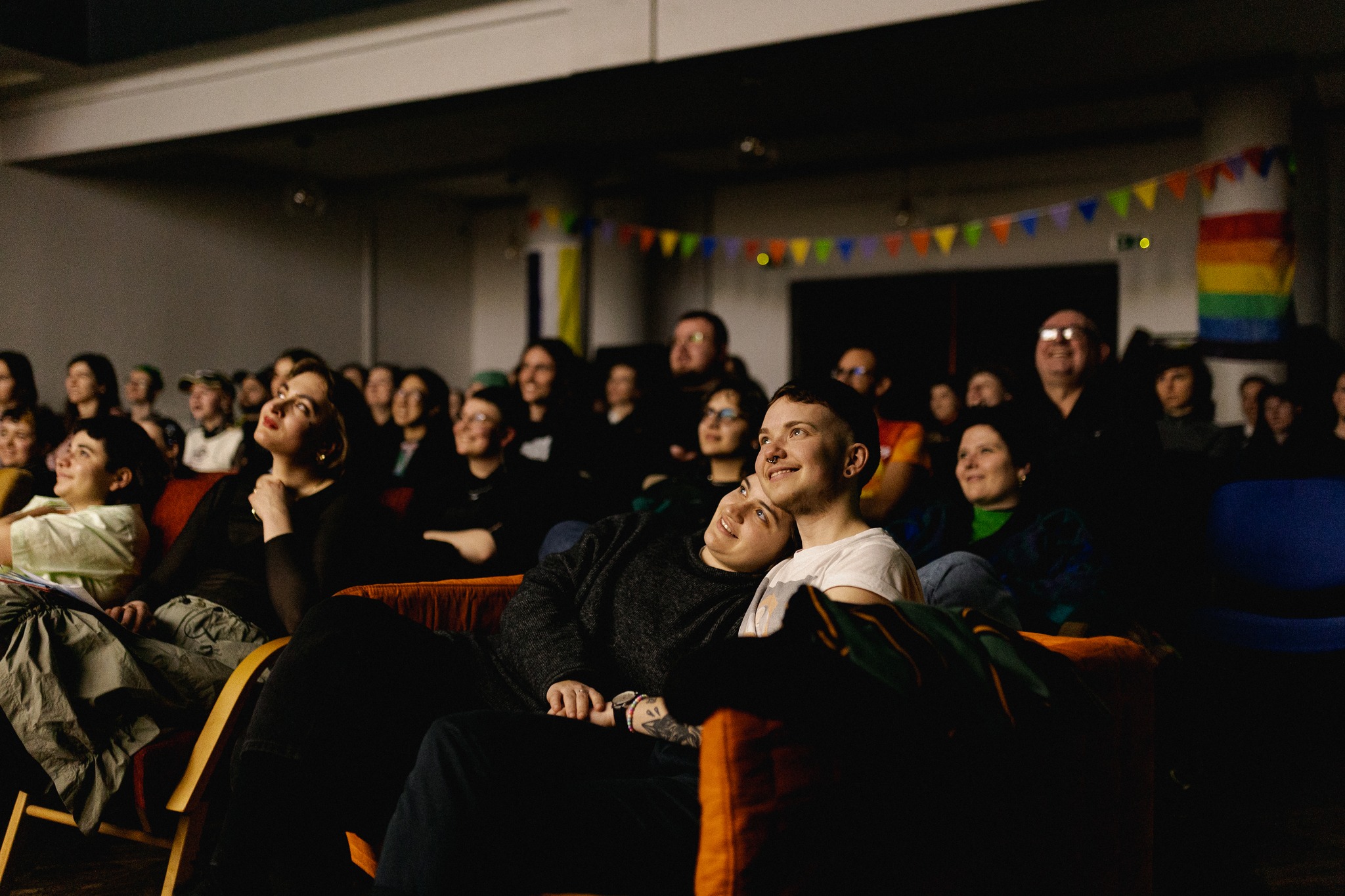Building Blocks of Your Community
SHOW GREAT FILMS
FOCUS ON PEOPLE
PROVIDE AN EXPERIENCE
AUTHOR: Veronika Hanáková, Film Curator (Kampus Hybernská, Czechia)

Building Blocks of Your Community
When you organize a cultural event with a documentary film screening, you do it for people to see and enjoy it and to incite a discussion. You want an audience to take the documentary film and share it, discuss it, and even question it. Only in this way do the films manage to connect not only different topics and phenomena but also people from different backgrounds. Being part of the KineDok network means creating and reinforcing a community of people who enjoy documentary films because these films reflect their own lives, broaden their knowledge about the world, initiate discussions about complex issues, and create space to share, connect, and laugh together. In this chapter, we will focus on the community-building aspect of screening films because a community does not arise spontaneously but needs to be built up gradually. Let's get started.
Beginning: Analyze
VENUE
PURPOSE
AUDIENCE
MOTIVATION

Analyze
Position of Your Venue: Among the KineDok community, a venue can have one of these three positions:
1) brand new cultural spot, i.e. without a connected community,
2) established venue that still needs a community interested in documentary films,
3) established venue with a history of screening fiction films and an established community.
Whether you are starting from scratch, or are an experienced film-screening venue, the following steps will inspire you to address your new community, or reinforce the existing one.

Content and Purpose: What is the purpose of your events? What do you want to achieve through documentary film screenings? These questions help you understand why you are part of KineDok and what you want to accomplish for your venue, location, and community. Select documentaries that bring something different, new, and entertaining to your venue.

Audience: Always think about the audience for whom the screenings are intended. Do you screen films because you want to empower your community? Do you want to educate or entertain them? Or do you want to create a program for overlooked audience groups (seniors, families with children, etc.)? Initially, it is advisable to identify one primary target group for your screenings, the accompanying program, and the promotion. It is better to start slowly. Don't bite off more than you can chew!

The First Step: The first screenings can be stressful; there will be some uncertainty about how many people will appear. Even if a relatively small number of people show up, don't panic! It's not about the numbers! At this moment, organizing cultural events is about creating a pleasant and welcoming atmosphere. Be welcoming, be kind, and be talkative. Audience numbers will gradually increase. But it will depend on whether that is your purpose and if you can attract the audience with your program (not only the film but also accompanying events, discussion, guests, etc.). The composition and volume of your audience are entirely up to you (and the possibilities of the venue).

Motivation: What do you want to get out of it as an organizer? Building a community can be a tedious process; be aware of your motivations and goals. Your goals might be to be active in the local community, to support the local cultural scene, or to build a new cultural center. The possibilities are endless.
Second Stage: Research
IDENTIFY YOUR COMMUNITY

Research
Understand Local Audiences: Finding a community audience for your documentary film screenings may be challenging. Sometimes, a community forms naturally after the first screening. Other times, only few people show up for the screening—the original target audience for your cultural events needs to be reconsidered as it might be clashing with an already existing local offer of cultural events. It's good to remember that your venue is not the only cultural or community player in town. Be sure to do your research on what other organizations offer cultural programs (you can specifically focus on film screenings), which communities they target, and with what content. This step might help you understand the local cultural scene and discover what cultural activities are missing and what communities are being forgotten. Also, think about whether and how a regular screening of documentary films can fill this gap.

There Is Not Only One Community: Trying to get documentary films out to the broadest possible audience is the primary goal of many KineDok venues, but getting there takes a lot of work. There is not just one community. On the contrary, many viewers come from different social, cultural, and economic backgrounds, are of different ages, have varying interests in specific topics, and come up with uniquely different questions. Ask yourself: How can I ensure that the cultural program offered in my venue engages different audiences and thus attracts diverse communities?

Research: 1) do some basic research on the cultural activities offered for different groups, what is available to them and why, 2) study the KineDok catalog, look for reviews and audience reactions, and analyze what they liked, didn't like, and why.
Ask: 1) consult your local KineDok coordinator for options and advice, 2) connect to other KineDok locations, 3) ask your local community (schools, clubs, senior residences, etc.) in what issues they are interested, 4) online.
Participate: 1) in local festivals and meetings, 2) club meetings, 3) cultural, sports, folklore, neighbourhood events.
Whether you focus on one community, create a program for multiple communities, or try to make a curated selection “for all,” these communities may have different requirements and expectations that you should keep in mind.

Identify Your Community: There are many communities in every town or village. It is very challenging to create a screening program and a follow-up debate or workshop to fit the needs of everyone. So feel free to focus on just a few. This focus will not only help with the selection of films and the accompanying program but also simplify the promotion of the event. It is a good idea to start slowly, focusing on a particular group of viewers (maybe your regular audience or the most neglected in your town/village) and gradually adding other groups. For example, if you screen every two weeks, one screening might be for families, and the second for people interested in social issues. This regularity will make it possible to create a cultural program for specific communities that will know when a film screening will occur. Over time, you can add on more film screenings, modify your target audience, or try to connect communities.
Third Stage: Plan
BE PREPARED
PLAN
COMMUNICATE

Plan
Accessibility: The primary step is to know your venue. Identify the potential and challenges of your venue (e.g., many stairs without an elevator, small toilets, accessibility/non-accessibility by public transport, walkability to and from your venue, or a playground nearby). To target specific communities, you must think about their needs well in advance. Once people arrive, you want them to feel welcome and not like an unexpected visitor. Respecting diversity is an active approach rather than silent observation.
"Respecting diversities among the audience is also desirable.”

Possible Scenarios for Different Groups:
“We screen outdoors and target parents with smaller kids who cannot stay home alone. So we provide the kids with a parallel program inside—they are creating something there, we provide them with food, and there is a responsible adult with them. Our new target group is older people; they will join us this Christmas for workshops. And I wish we also had a younger audience, like teenagers, but they prefer going to a different venue that is more for them.”
“We always try to have something for children, both serious and not-so-serious films, to meet the taste of a broader audience. We organize filmmaking workshops for children, and we then screen it before the official program. So, we combine a younger audience with their parents. Since the screenings are free, random tourists can walk in and sit and watch for 10–15 minutes and then move on. The atmosphere is very relaxed.”
Ana

Be Prepared, Plan, and Communicate: Organizing a film screening is a time-consuming job. It is essential to have a program schedule and the technical facilities in place and to make sure the film and accompanying program are ready.
“Before the screening, we watch each film and prepare the whole event; we have our groups and chats where we share ideas.”
Don't panic and ask for help
However, if something goes wrong or you get negative feedback, don't panic; try to solve the problem immediately and communicate it to the audience. Working with the feedback from the audience and guests regularly can improve your program and your impact. Feel free to ask for help in the community; you can even involve them in selecting films, preparing accompanying programs, etc.
Notes and Sources
PHOTOS:
GLISNÍKOVÁ, Lenka; JASNÝ, Michal; MRÁČEK, Adam; PATYCKI, Michał and Ivana TVRDÁ
Archive of our screening venues (Prádelna, Rabenštejnská 2020)
We live the documentary film, be there with us.
Start each month with a fresh dose of information. Subscribe to the newsletter.
I hereby consent to the processing of the personal data.










